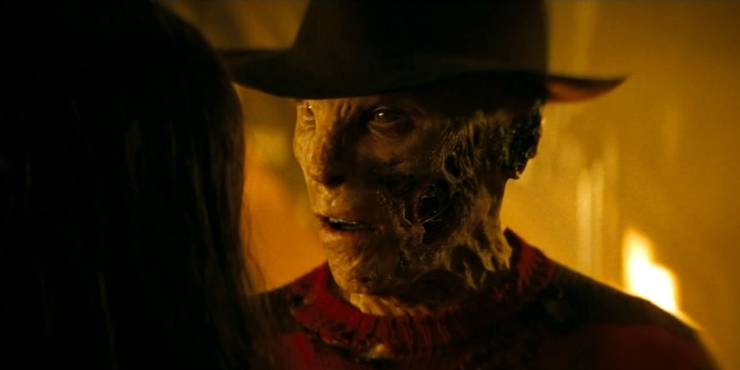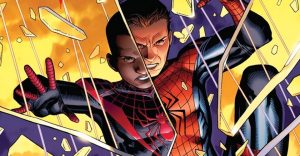Nightmare On Elm Street Full Movie Franchise Timeline Explained

A Nightmare on Elm Street is one of the most successful horror franchises of all time, meaning that producers capitalized on numerous sequels to build the strange, supernatural universe of Freddy Krueger in a somewhat confusing timeline. The films generally take place in chronological order, but there are key details of Freddy’s backstory that were revealed over the span of several installments. Beyond this, not every single one of the Elm Street movies is considered canon.
More sequels meant more convoluted reasons to resurrect Freddy, as well as more reasons to complicate the plot and origins of the character. Despite the confusing nature of the flashbacks and time jumps, however, it is possible to come up with a relatively clear timeline of events to trace the adventures and experiences of Freddy and his victims. For a slasher franchise, it’s certainly not as complex and bewildering as its contemporaries like Friday the 13th.
The following is the complete timeline of the Elm Street cinematic franchise with an explanation as to which entry the events occurred in. It’s important to note that Freddy’s backstory is often referenced and expanded on in multiple different films, especially the oft-maligned Freddy’s Dead: The Final Nightmare. That being said, the series rarely, if ever, retcons important details despite its tendency to fall victim to sloppy continuity errors, making for a clean reading of the history of Freddy Krueger. That is, of course, save for the increasingly nonsensical ways Freddy Krueger returns from the dead.
1907 to circa 1940: Amanda Krueger

The third and fifth Elm Street films, Dream Warriors and The Dream Child, give information on Amanda Krueger, the mother of Freddy, who was born in 1907. She decided to become a nun under the name of Sister Mary Helena and, in 1925, started working as a nurse at The Hathaway House asylum for the criminally insane, located in Springwood, Ohio. Some time in the early 1940s, she was accidentally locked in the place over the holidays and was raped by the inmates, lending Freddy Krueger his dramatic moniker of “the bastard son of a hundred maniacs“.
1940s: Freddy’s Childhood

A peek inside Freddy’s mind in Freddy’s Dead: The Final Nightmare reveals his tormented upbringing, complete with an alcoholic, abusive foster father and classroom bullies who teased him for his perverse birth. The slasher’s sociopathic tendencies already start to develop, as evidenced by his murder of the class hamster. He also learns about the power of pain through self-harm, and eventually kills his adopted dad.
1960s: Freddy’s Marriage and Arrest

The Final Nightmare goes on to explain that, at some unspecified point in his life, Freddy got married to a woman named Loretta. In 1961, their daughter Kathryn is born, but this happy family would become untangled when Loretta discovers her husband’s dark, twisted secret. When the Springwood Slasher begins terrorizing their town, Loretta discovers a demented trove of violent devices, including the iconic bladed glove, in the basement of 1428 Elm Street. When she confronts an angry Freddy, her husband kills her in front of their child. Freddy gets arrested for the murders, while Kathryn is placed in adoption services and gets her name changed to Maggie Burroughs. A blackboard within a scene in The Final Nightmare shows that these events occurred in 1966.
1968: Freddy’s Trial and Murder

The death of the earthly Freddy Krueger is the most famous piece of the character’s history, and the earliest backstory to appear, first appearing in the original A Nightmare on Elm Street and then expanded on in The Final Nightmare and revisited in Freddy vs. Jason. Nancy Thompson’s mother, Margaret, tells her daughter in the first film that “the lawyers got fat and the judge got famous, but someone forgot to sign the search warrant in the right place“, and Freddy was let off on a technicality. In retaliation, the parents of the twenty murdered Elm Street children go to the power plant Freddy works at and burn him to death in his boiler room lair where he killed his victims.
The Final Nightmare explains that Freddy got his power to return from the grave from “dream demons”, those notoriously cheap-looking ghost effects that people so often criticize. According to the lore, they seek out the evilest soul they can find in order to grant the power to exist after death in the dreams of others. This is where Freddy gets the ability to turn dreams into reality, thereby vengefully killing his dream victims in the real world.
1981: A Nightmare on Elm Street

Thirteen years after Freddy’s death, the murderer reappears in the dreams of Elm Street’s newer teenage residents. He lives on the fears and memories of Springwood’s inhabitants, taking revenge on those who burned him alive by killing the town’s young souls. Nancy Thompson, who now lives in the house at 1428 Elm Street, uncovers this history and fights back against the slasher. The unforgettable ending of the movie, however, reveals that Freddy is still alive, ready to enact his vengeance on Nancy. Luckily for her, the third movie reveals that in the six years that follow, she was sent away to a psychiatric hospital and graduates college with a psychology degree after obtaining the dream suppressant, Hypnocil.
1986: A Nightmare on Elm Street 2: Freddy’s Revenge

Meanwhile, Jesse Walsh (Mark Patton) moves into 1428 Elm Street and becomes plagued with horrible nightmares. He discovers Nancy’s diary, in which he learns about her dreams that sound similar to his own. Freddy begins to command Jesse to kill others in an attempt to possess the boy and re-enter the world of the living. However, Jesse’s romantic interest, Lisa, manages to save Jesse by proclaiming her love for him and banishing Freddy from his body. That is, of course, until the final seconds of the movie imply that the slasher still lives.
1987: A Nightmare on Elm Street 3: Dream Warriors

Nancy, who it turns out has actually survived the events of the first film, is now working at Westin Hills Psychiatric Hospital as an intern therapist with her psychology degree. She discovers that one of the patients, Kristen, has the power to pull people inside of her dreams, and that those who are suffering from nightmares at the facility are the last surviving children of the parents that burned Freddy. Nancy bands together with the others to try to destroy the killer in their dreams, but she tragically dies while fighting Freddy. The ghost of Amanda Krueger also guides Dr. Neil Gordon to bury the remains of her son in order to stop his murders for good. At the end of the movie, Kristen and her fellow patients, Kincaid and Joey, are the only survivors.
1988: A Nightmare on Elm Street 4: The Dream Master

Freddy was actually, bona fide dead in Dream Warriors, so The Dream Master resurrects him in the weirdest, most insensible way. Kincaid’s dog, Jason—in what is what can now be seen as an amusing bit of accidental foreshadowing for the future crossover slasher film—pees on Freddy’s burial spot while the urine stream of insights in flames. Kristen eventually falls prey to Freddy, but she grants her friend, Alice Johnson, her dream powers before she dies. Alice manages to kill Freddy, this time by reciting a nursery rhyme and showing him a mirror that tears the souls of his victims out of his body to rip him apart.
1989: A Nightmare on Elm Street 5: The Dream Child

Alice and Dan, the love interest of the previous film, are now in a romantic relationship with each other. Unfortunately, Alice starts having visions of Amanda Krueger’s traumatizing experiences at the asylum, including the birth of Freddy. This somehow resurrects him and inspires him to go on a quest to transfer his victims’ souls to Alice’s unborn child, Jacob, in order to continue his evil legacy. Alice asks her friend Yvonne to go travel to the asylum ruins to lay the bones of Amanda to rest, allowing the ghost of Freddy’s mother to travel to the dream world to capture her son and set Jacob free.
1999: Freddy’s Dead: The Final Nightmare

Freddy’s Dead apparently takes place ten years after the last movie, meaning that it has to take place in 1999, despite being released in 1991. Maggie Burroughs, formerly known as Kathryn Krueger, is working as a psychologist at a youth shelter. When she uncovers that one of her patients, a boy named John who is suffering from Freddy-induced nightmares, is holding newspaper clippings about the Springwood killings, she goes on a road trip to investigate her origins. According to The Final Nightmare, it’s the dream demons that keep Freddy continuously coming back movie after movie. Why such a powerful force of supernatural immortality is able to be blown up with dynamite is anyone’s guess.
2003: Freddy vs. Jason

Despite killing off almost all of the teenagers in Springwood, Ohio and driving the town’s populace mad in The Final Nightmare, everyone living there has forgotten about Freddy and has weakened his power. Forced to reside in hell until gaining strength, he enlists Jason Voorhees while disguised as the slasher’s mother Pamela to go on a killing spree in Springwood. Unfortunately for Freddy, Jason starts stealing his victims, and the teens in the movie are able to pull him out of the dream world to make him fight against his ally-turned-nemesis. Freddy is decapitated, but winks at the camera at the end of the film.
Other Timelines In The Nightmare On Elm Street Franchise

The seventh film in the franchise, the meta-horror Wes Craven’s New Nightmare, as well as the 2010 remake of A Nightmare on Elm Street, are considered to take place outside of the main cinematic timeline. New Nightmare takes place in the “real world”, and involves Freddy tormenting the cast and crew of the first film, including Nancy’s actress Heather Langenkamp. The 2010 film is a reboot, with changes made to the original story intended to create a more menacing atmosphere in contrast to the silly tone the later sequels developed.
About The Author

















